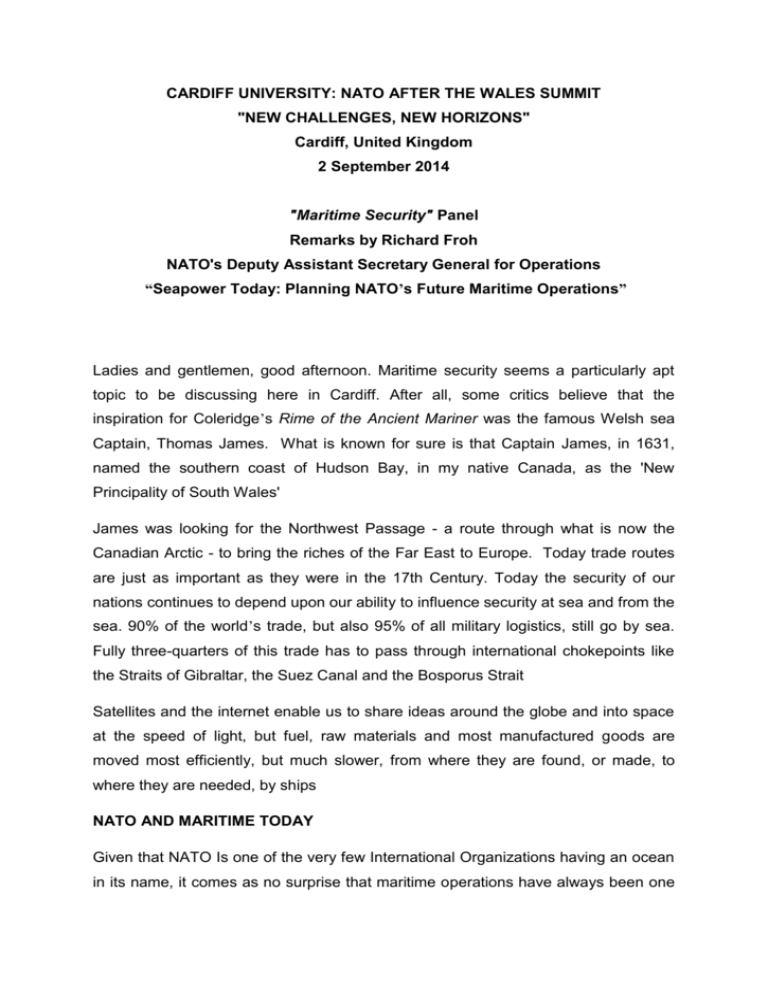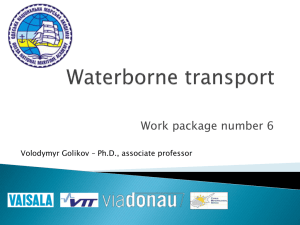Seapower Today: Planning NATO`s Future
advertisement

CARDIFF UNIVERSITY: NATO AFTER THE WALES SUMMIT "NEW CHALLENGES, NEW HORIZONS" Cardiff, United Kingdom 2 September 2014 "Maritime Security" Panel Remarks by Richard Froh NATO's Deputy Assistant Secretary General for Operations “Seapower Today: Planning NATO’s Future Maritime Operations” Ladies and gentlemen, good afternoon. Maritime security seems a particularly apt topic to be discussing here in Cardiff. After all, some critics believe that the inspiration for Coleridge’s Rime of the Ancient Mariner was the famous Welsh sea Captain, Thomas James. What is known for sure is that Captain James, in 1631, named the southern coast of Hudson Bay, in my native Canada, as the 'New Principality of South Wales' James was looking for the Northwest Passage - a route through what is now the Canadian Arctic - to bring the riches of the Far East to Europe. Today trade routes are just as important as they were in the 17th Century. Today the security of our nations continues to depend upon our ability to influence security at sea and from the sea. 90% of the world’s trade, but also 95% of all military logistics, still go by sea. Fully three-quarters of this trade has to pass through international chokepoints like the Straits of Gibraltar, the Suez Canal and the Bosporus Strait Satellites and the internet enable us to share ideas around the globe and into space at the speed of light, but fuel, raw materials and most manufactured goods are moved most efficiently, but much slower, from where they are found, or made, to where they are needed, by ships NATO AND MARITIME TODAY Given that NATO Is one of the very few International Organizations having an ocean in its name, it comes as no surprise that maritime operations have always been one of NATO's strengths. From the Atlantic to the Mediterranean, from the Baltic to the Black Sea, and even out into the Indian Ocean, NATO’s maritime experience is unmatched To illustrate my point, let me say a few words about our two currently ongoing maritime operations Off the Horn of Africa, every day our maritime forces are working closely with other navies and the shipping industry to protect humanitarian aid vessels, to keep. International shipping lanes open, and to suppress piracy off the coast of Somalia. Operation Ocean Shield was launched in 2009. Alongside EU Naval Force (EUNAVFOR), the Combined Maritime Force (CMF) and the navies of other nations - often called the independent deployers, NATO has contributed to the steady decrease of piracy off the coast of Somalia, particularly since 2012. Together our cooperative effort has been so successful that today there are only thirty-seven hostages still being held by pirates, and no ships. Quite a change from the situation in 2010 and 2011 Our other ongoing maritime operation is Active Endeavour – which was part of the Alliance’s response to the 9/11 attacks in 2001. This operation is focused on countering terrorist activity in the Mediterranean and building a picture of maritime activity there. The operation has given us valuable experience in conducting multilateral maritime operations in today’s security environment. But it’s also had a tangible effect on security and stability in the region that has led a better environment in which to conduct trade and economic activity. It’s worth remembering that 65% of the oil and natural gas consumed in Western Europe passes through the Mediterranean. To carry out such an operation, it was necessary to create a very adaptable framework. Now, we can draw on that framework to respond to future crises In both these operations – Ocean Shield and Active Endeavour – Partners have played an important role The shift from the decades of the Cold War, to where we are now, has huge in terms of Alliance organization and mindset. Today, rather than four or five NATO military headquarters responsible for maritime planning, training and operations; we have a single Allied Maritime Command. It’s located here in the UK, in Northwood. This headquarters provides NATO with a more agile, operational hub able to plan and conduct current and future NATO operations, where maritime forces are the only or the main component. This helps us adapt to today’s complex and increasingly unpredictable security environment. Maritime security today is marked by a combination of often interrelated threats – such as piracy, armed robbery at sea, boundary disputes, illegal fishing, drug smuggling, and human trafficking. To meet these diverse threats, we need to leverage our available assets and infrastructure. We’re also fundamentally rethinking the way we deploy our naval capabilities. But, the high-seas also remain a place for great power politics. This aspect has, unfortunately, taken on renewed importance in light of recent events in Ukraine. NATO has been forced to seriously re-examine some of our fundamental assumptions about the post-Cold War security environment. One outcome has been the decision – which NATO’s Heads of State or Government will endorse on Friday – to make a better effort to implement the Alliance Maritime Strategy. We’re living in a troubled and uncertain world. The stakes are high. So whether they’re looking at it from an economic or a strategic security perspective, I think all the Allies realise that increased investment in maritime capabilities is no longer an option, but a necessity. THE ALLIANCE MARITIME STRATEGY NATO’s first, Maritime Strategy was published in 1984. As you can imagine, it was heavily couched in the language of the Cold War. It was really a strategy geared towards being ready for a peer-on-peer conflict on the high-seas. After the breakup of the Soviet Union in 1991 – and with the terrorist attacks on the USA in 2001 – it became apparent that that the 1984 strategy needed to be adapted to the new international security environment and its much different threats. So a new Alliance Maritime Strategy was produced in 2011. The new Strategy is much broader than the 1984 version, and lays out four situations where NATO must be ready to conduct maritime operations. The first three are the ‘core tasks’ of NATO, as set out in the 2010 Alliance Strategic Concept. These are: deterrence and collective defence, crisis management, and cooperative security. The fourth is the support of maritime security, more broadly. As a first step to implementing this new maritime strategy, a conceptual document was prepared in 2011 that sets out the types of maritime security tasks NATO should be able to undertake. These are: supporting Maritime Situational Awareness (knowing what is going on under, above and on international waters); upholding freedom of navigation for all; conducting maritime interdiction; combating the proliferation of weapons of mass destruction; protecting critical infrastructure; supporting counter-terrorism efforts; and contributing to maritime security capacitybuilding. With these two documents - the Strategy and the Concept, the key elements are in place for a reinvigoration of NATO maritime capabilities. The Strategy is comprehensive – and certainly ambitious, while the Concept is clear and more focused. But to be of any value, both must be implemented. Direction to do so, is one of the decisions we expect from our leaders here at the Wales Summit, later this week THE WALES SUMMIT INITIATIVE On Friday, our Heads of State and Government will be invited to launch a major maritime initiative that will give NATO the ability to effectively implement the 2011 strategy. This initiative will include greater engagement, training, readiness, force generation, and the development of new maritime capabilities. Perhaps the most important feature of this initiative will be a reinvigoration of our Standing Naval Forces. To be honest, for a number of years now, NATO’s Standing Naval Forces have been plagued by a lack of commitment among the nations. To convince allies to contribute more capabilities to the Standing Naval Forces, we must demonstrate that we’re making the best use of our existing capabilities. In the last five-to-ten years, the Standing Naval Forces have been used for operations that nations weren't prepared to resource with surface, subsurface and maritime air power capabilities – through the normal force generation process. That has been the case with Operation Ocean Shield. The Initiative proposes that we shouldn't use the Standing Naval Forces for protracted operations, or for operations with low-end tasks. Doing this will mean that these forces will be better able to fulfill their core task, which is to provide a ready, effective, multinational standing maritime capability for the Alliance to use in periods of crisis and conflict.. The initiative will also allow us to build a multi-year program of high-value training and exercises for the Allied navies – and where appropriate, Partner navies – and establish flexible engagement schedules, making them more attractive to the nations. Education, training, exercises and evaluation for our maritime forces are another big part of what we need to accomplish. We need to improve our ability to conduct the full spectrum of maritime operations – those laid out in the 2011 conceptual document I mentioned earlier. But our program must be sufficiently varied, challenging, and flexible, that it will attract the interest of Allied navies. Our Partners should see something in it for them too Finally, the Wales Maritime Initiative will also focus on enhancing our engagement with partner and non-partner nations, as well as look for ways of enhancing NATOEU coordination, cooperation and complementarily. When we act in concert – as with anti-piracy operations off the Horn of Africa – we are all more effective. Going forward, we want to avoid unnecessary duplication, and identify areas where our cooperation with our partners can grow. . Now you may be wondering, who’s going to be footing the bill for all of this? The good news is that for the most part, the proposals I’ve outlined don’t require us to spend more, but rather to spend better. We need to make the best use of our existing capabilities. There shouldn’t be large, new demands on NATO’s or nations’ budgets. Working together, as an Alliance and with our Partners, we can make this intensified maritime engagement more appealing, as well as mutually beneficial. CONCLUSION In the Wales Maritime Initiative, we’ve drawn on NATO’s long and rich experience in maritime training and operations. The way forward lies in pursuing multinational approaches, strengthening the transatlantic compact, and engaging with our partners in a spirit of cooperation. We must retain our ability to project peace and security wherever necessary; in the interest of our Alliance its members The Oceans have been the highways of trade and economic growth throughout history. And success or failure on the high-seas has determined the fates of nations. Those who failed the naval-power test – Alexander, Napoleon, Philip II – also failed the test of time. Today, Russia’s aggressions have undermined security in Europe. Developments on NATO’s Southern Flank – particularly in the Middle East and North Africa – are changing the broader security environment This week, at the Wales Summit, the NATO Heads of State and Government will adopt a Readiness Action Plan with the goal of making the Alliance faster and more agile in responding to the range of threats we face today, in particular those posed by Russia. Reinvigorated and forward-looking maritime capabilities will be a key component of that plan. Sea power continues to give NATO a means of acting swiftly and decisively, by exploiting a domain in which our forces are able to operate without serious challenge. As President Theodore Roosevelt said in his second annual report to the US Congress, "A good Navy is not a provocation to war. It is the surest guarantee of peace."







